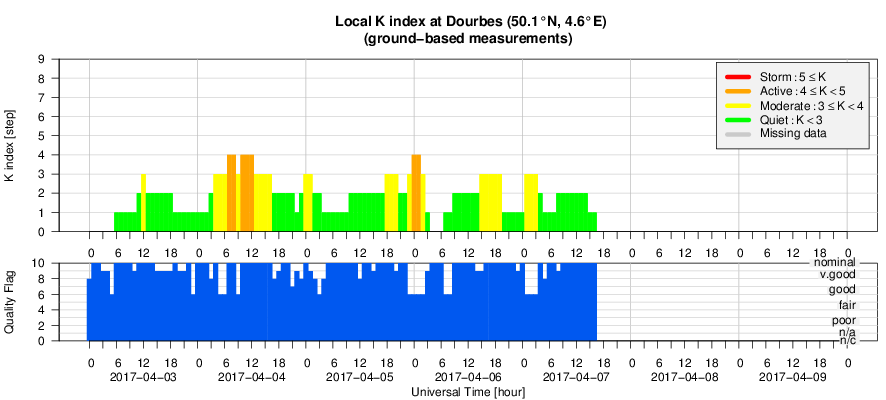- Table of Content
- 1.Airplane trans...
- 2.The Sun seen b...
- 3.PROBA2 Observa...
- 4.Review of sola...
- 5.Noticeable Sol...
- 6.The Internatio...
- 7.Geomagnetic Ob...
- 8.Future Events
2. The Sun seen by a ground based-telescope: brilliant
3. PROBA2 Observations (3 Apr 2017 - 9 Apr 2017)
4. Review of solar and geomagnetic activity
5. Noticeable Solar Events (3 Apr 2017 - 9 Apr 2017)
6. The International Sunspot Number
7. Geomagnetic Observations at Dourbes (3 Apr 2017 - 9 Apr 2017)
8. Future Events
Airplane transits the Sun!
Emil Kraaikamp is a famous astrophotographer working as an IT specialist at the Royal Observatory of Belgium. A few years ago, he wrote the image processing software AutoStakkert!2 (http://www.autostakkert.com/wp/ ), which is now used by astrophotographers worldwide and has been featured in the September 2016 issue of Sky and Telescope (http://www.skyandtelescope.com/sky-and-telescope-magazine/inside-the-september-2016-issue/ ), one of the principal journals for the amateur astronomical society.
Two weeks ago, on 28 March, Emil was 'lucky' enough to capture a plane transit event during high cadence observations with the USET solar telescopes (Uccle Solar Equatorial Table; http://www.sidc.be/uset/ ). These observations were part of a joint solar observation campaign with satellites such as SOHO (SUMER; https://sohowww.nascom.nasa.gov/about/instruments.html ), IRIS (https://www.nasa.gov/mission_pages/iris/index.html ) and HINODE (http://hinode.nao.ac.jp/en/ ), and other groundbased instruments.
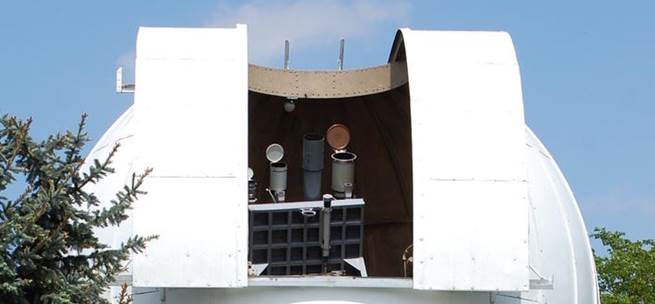
The USET platform contains 4 telescopes: 2 for white light observations (one for drawings, one for CCD imaging), one for H-alpha observations (a line in the red part of visible light), and one for Ca-K (a line in the blue part of the visible light). As Emil was recording the Sun in both H-alpha and Ca-K, a plane transited the solar disk, as can be seen in the imagery underneath and the movies at http://www.stce.be/movies/Airplane_H-Alpha.mp4 (H-alpha) and http://www.stce.be/movies/Airplane_CaK.mp4 (Ca-K). The two sunspot groups that are prominently visible are NOAA 2644 (near the center of the solar disk) and NOAA 2645 (to the left).
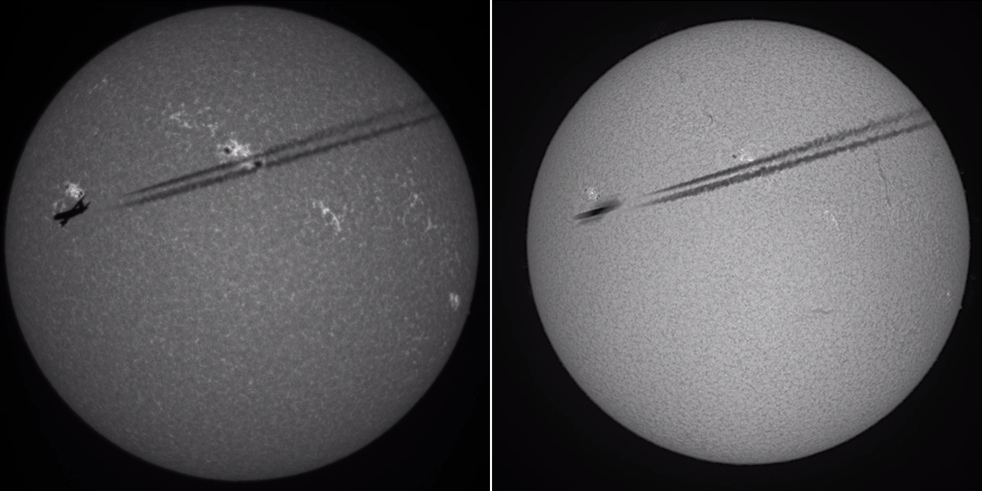
Emil explains that because of the longer exposure time in H-alpha (+/- 80ms), the airplane is a bit blurry there, but Ca-K was able to freeze the movement quite well with just 5 ms of exposure per frame. The two fuzzy stripes to the right of the airplane are condensation trails ("contrails") from the aircraft's exhaust (see the Contrailscience website at http://contrailscience.com/contrails-are-condensation-but-not-like-your-breath/ for more info). The airplanes can also be tracked, although not for very long and they obviously need to exactly pass the solar disc. A very nice clip is at http://www.stce.be/movies/Airplane_CaK_tracking.mp4 (Ca-K).
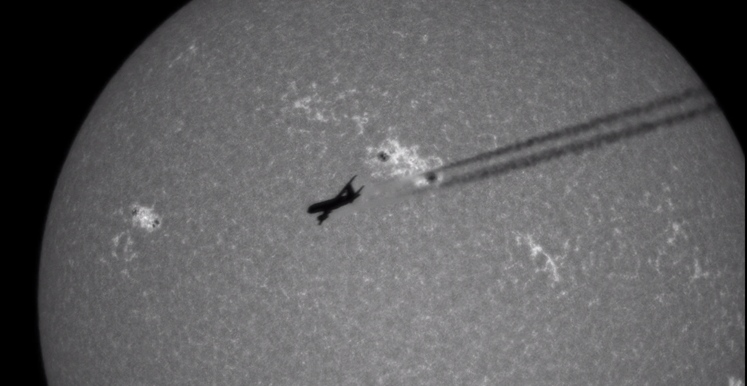
The remaining challenges are now to apply the image processing techniques to the entire dataset that was captured during the more-than-a-week-long observation campaign. (Un)fortunately, the weather was quite good, so Emil and his team expect to have quite a bit of fun with the several Terabytes of data waiting to be processed. With Brussels National Airport nearby, there's a good chance there will be more planes adorning the USET solar images!
The Sun seen by a ground based-telescope: brilliant
The M5 flare of April 2 was captured by the ground based H-alpha telescope mounted on USET. The video is the result of analysing almost 50.000 images!

You just enjoyed one of the first results of a coordinated observation campaign between ground- and space-based instruments. The campaign was set up to squeeze the last drop out of the instrument SUMER onboard of the spacecraft SOHO before it is shut down forever.
It is an impressive list of international teams that joined their forces for this last tribute: the spacecrafts IRIS, Hinode, PROBA2, the ground based observatories Catania (Italy), GREGOR (Germany), Kanzelhohe (Austria), Lomnicky (Slovakia), MSDP (France), NVST/ONSET (China), Ondrejov (Czech), Pic-du-Midi (France), USET (Belgium) and SST (New Mexico).
The movie in mp4-format: http://www.stce.be/movies/20170402_0720-1030_HA_30fps_c20_265.mp4
More info on USET, Brussels, Belgium: http://sidc.oma.be/uset/
PROBA2 Observations (3 Apr 2017 - 9 Apr 2017)
Solar Activity
Solar flare activity fluctuated between very low and moderate during the week.
In order to view the activity of this week in more detail, we suggest to go to the following website from which all the daily (normal and difference) movies can be accessed: http://proba2.oma.be/ssa
This page also lists the recorded flaring events.
A weekly overview movie can be found here (SWAP week 367):
http://proba2.oma.be/swap/data/mpg/movies/weekly_movies/weekly_movie_2017_04_03.mp4
Details about some of this week's events, can be found further below.
If any of the linked movies are unavailable they can be found in the P2SC movie repository here:
http://proba2.oma.be/swap/data/mpg/movies/
Monday Apr 03
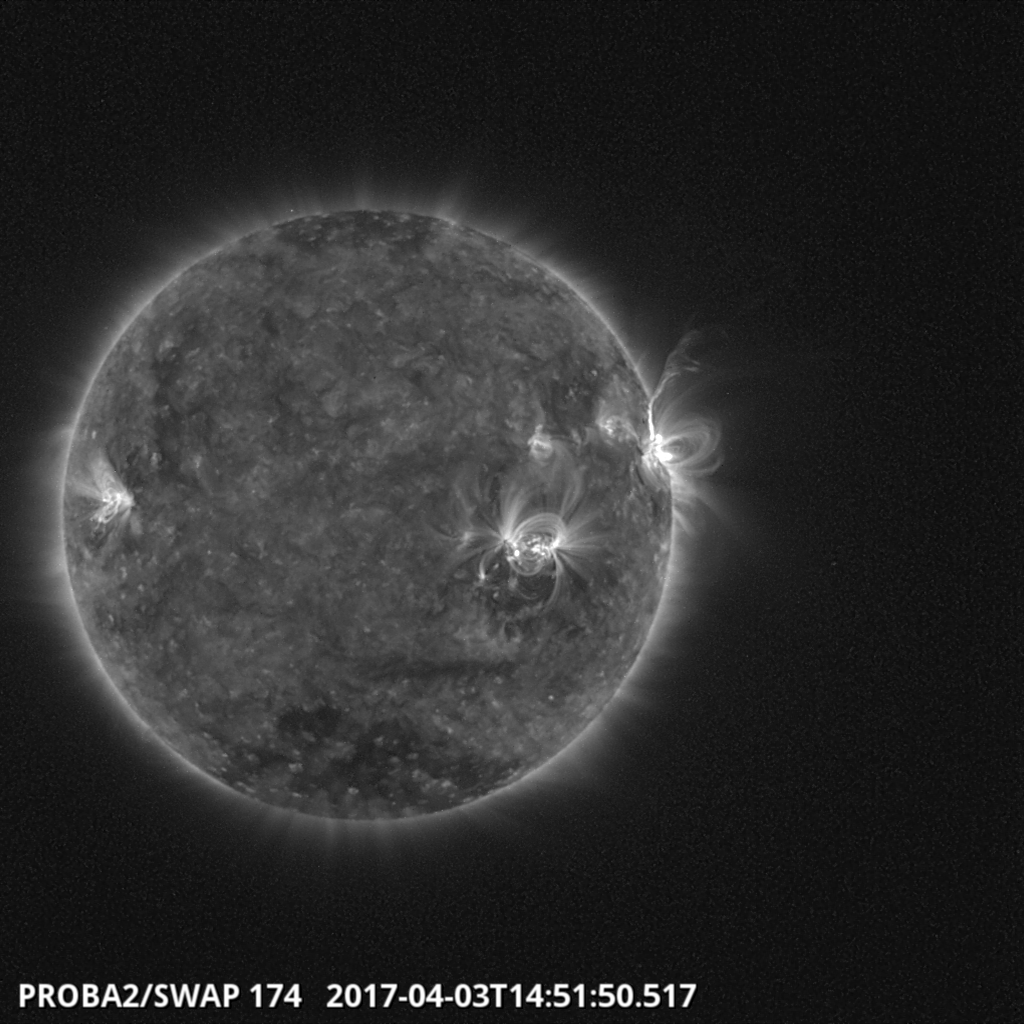
SWAP observed the largest flare of the year so far (M5.8) and a corresponding eruption near the west limb of the Sun on 2017-Apr-03, shown here at 14:51 UT, while SWAP was off-pointed to the solar west.
Find a movie of the event here (SWAP movie of off-pointed images between 13:00 and 18:00 UT):
http://proba2.oma.be/swap/data/mpg/movies/20170403_swap_movie_with_offpoint.mp4
Tuesday Apr 04
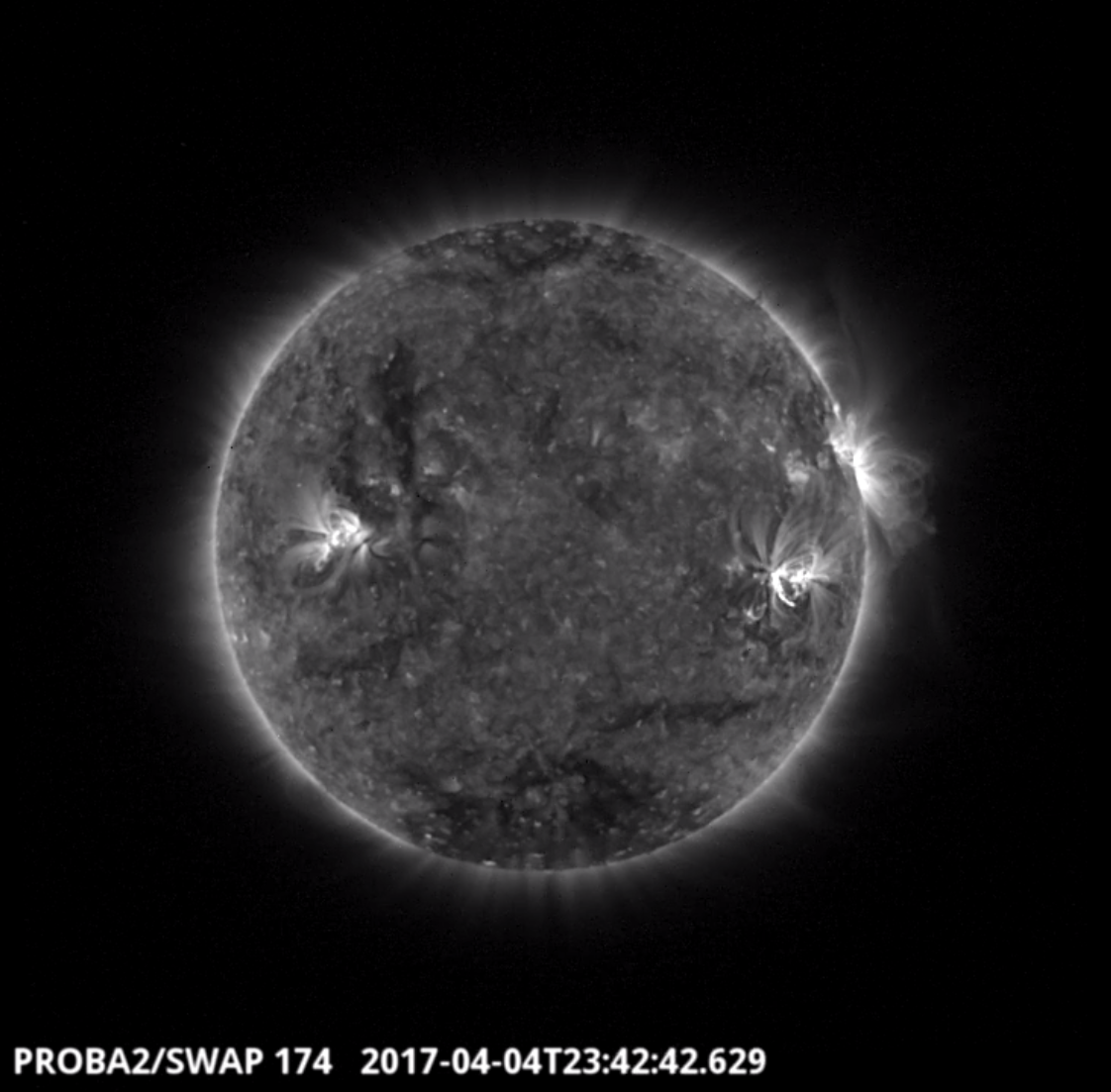
SWAP continued to observe multiple flares from NOAA AR2644 as it rotated towards the west limb, but the largest flare (C4.9) of the day was produced by NOAA AR2645, also in the western hemisphere, shown here at 23:42 UT.
Find a movie of the event here (SWAP movie):
http://proba2.oma.be/swap/data/mpg/movies/20170404_swap_movie.mp4
Review of solar and geomagnetic activity
Solar Activity
Solar activity varied from high at the beginning of the week to very low at the end of the week. NOAA 2644 produced 2 M-class events on 3 April, including an M5.8 flare peaking at 14:29UT. It continued to produce C-class flares until early on 5 April, when it had already fully rotated over the west limb. NOAA 2645 contained several delta structures, but was relatively quiet with only a modest number of C-class flares before it fully rotated off the solar disk late on 7 April. The Sun was reported spotless on 8 April, but on 9 April a small and inactive sunspot region appeared from behind the east limb (NOAA 2650).
Solar active region evolution:

NOAA 2644 - M2.1 LDE and M5.7 flare

NOAA 2644 - M5.8 flare

No significant flaring (C-class or higher) was observed on 9 April. The coronal mass ejections (CMEs) associated with the flaring activity had no earth-directed component. The greater than 10MeV proton flux was at nominal levels. Small coronal holes (CH) were in geo-effective positions throughout the week.
Geomagnetic Activity
The earth environment was under the influence of coronal hole wind streams most of the week, with particular wind speed enhancements on 4 (up to 470 km/s), 6 (around 500 km/s) and 8-9 April (maximum values near 630 km/s). Bz varied between -13 and +13 nT on 4 April, and between -8 and +7 nT for the rest of the week. The phi angle was mostly directed towards the Sun ("negative"), with the "away" direction dominating on 4 and 9 April.
Based on Potsdam and incomplete Dourbes geomagnetic recordings, active conditions were reported on all days of the period except on 3 and on 6 April (quiet to unsettled only). NOAA Kp was at minor storming levels on 4 April (Dst = -66 nT at 12UT) and again on 9 April (Dst = -39 nT on 02-03UT).
Review the Monday Space Weather Briefing:
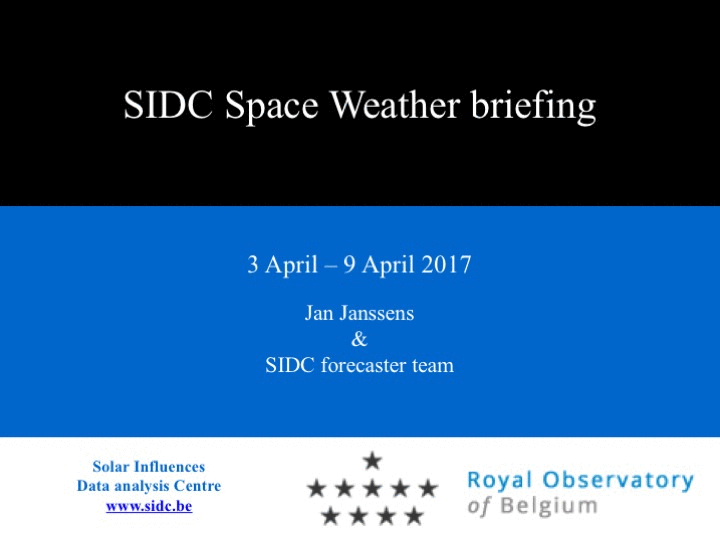
Noticeable Solar Events (3 Apr 2017 - 9 Apr 2017)
| DAY | BEGIN | MAX | END | LOC | XRAY | OP | 10CM | TYPE | Cat | NOAA |
| 03 | 0056 | 0105 | 0112 | N15W75 | M1.2 | SF | 8 | 2644 | ||
| 03 | 1419 | 1429 | 1434 | M5.8 | 100 | II/2IV/1 | 8 | 2644 |
| LOC: approximate heliographic location | TYPE: radio burst type |
| XRAY: X-ray flare class | Cat: Catania sunspot group number |
| OP: optical flare class | NOAA: NOAA active region number |
| 10CM: peak 10 cm radio flux |
The International Sunspot Number
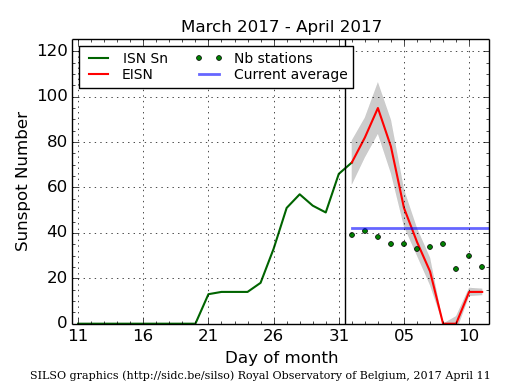
The daily Estimated International Sunspot Number (EISN, red curve with shaded error) derived by a simplified method from real-time data from the worldwide SILSO network. It extends the official Sunspot Number from the full processing of the preceding month (green line). The plot shows the last 30 days (about one solar rotation). The horizontal blue line shows the current monthly average, while the green dots give the number of stations included in the calculation of the EISN for each day.
Future Events
For more details, see http://www.spaceweather.eu/en/event/future
URSI General Assembly in Montreal, Canada
Start : 2017-08-19 - End : 2017-08-26
For the thirty-second time since the inception of URSI, Radio
Scientists from across the world will get together for the URSI
General Assembly and Scientific Symposium. This triennial gathering
will take place from 19th to 26th of August 2017, in Montreal,
Canada. This conference is a unique opportunity to learn about
recent advances in all fields of Radio Science, as covered by all
ten URSI Commissions.
Among the different sessions, please note:
* 'Radio Science for Space Weather'
Conveners: M. Messerotti, V. Pierrard
* 'Remote Sensing and Modeling of the Earth's Plasmasphere
and Plasmapause'
Conveners: A. M. Jorgensen, V. Pierrard, B. Heilig
The abstract deadline is 30 January 2017
Website: http://www.ursi2017.org
2017 Joint IAPSO-IAMAS-IAGA Assembly in Cape Town, South Africa
Start : 2017-08-27 - End : 2017-09-01
The Joint IAPSO-IAMAS-IAGA Assembly, endorsed by the University
of Cape Town and the South African Department of Science and
Technology, will take place from 27 August to 1 September 2017 at
the Cape Town International Convention Centre (CTICC). Several IAGA
and IAMAS sessions are of Space Weather interests as well as the
joint session 'Space Weather throughout the Solar System: Bringing
Data and Models together'.
Website:
http://iapso-iamas-iaga2017.com/index.php
Workshops on Radiation Monitoring for the International Space Station in Torino, Italy
Start : 2017-09-05 - End : 2017-09-07
The Workshop on Radiation Monitoring for the International Space
Station is an annual meeting to discuss the scientific definition
of an adequate radiation monitoring package and its use by the
scientific community on the ISS. Types of instruments and research
topics need to be defined in order to optimise the radiation safety
of the ISS crew.
Website: http://wrmiss.org/
International Workshop on Solar, Heliospheric & Magnetospheric Radioastronomy in Meudon, France
Start : 2017-11-06 - End : 2017-11-10
Jean-Louis Steinbeg has been one of the major pioneers in
radioastronomy. Co-founder of the Nançay Observatory, he
has actively participated to, an inspired a large number of radio
instruments on many international space missions. Jean-Louis
Steinberg is the founder of the Space Radioastronomy laboratory of
the Paris Observatory in 1963. Later on, this laboratory widened
its science interests and became the DESPA (1971) and then the
current LESIA (2002) which is one of the major space sciences
laboratories in France. The aim of this workshop is to cover the
science topics which Jean-Louis Steinberg has promoted during his
career, focusing on Solar, Heliospheric & Magnetospheric
radioastronomy & physics. This will be done by covering both
observations from either ground facilities (NDA, RH, LOFAR, Artemis
etc ...) or space missions (ISSEE, Ulysses, WIND, CLUSTER, STEREO,
CASSINI, JUNO etc ...) and models/theories. A series of invited
talks is also foreseen to cover the new developments in the
discipline which may come with the future facilities such as Solar
Orbiter, Solar Probe Plus, JUICE, JUNO, LOFAR+, SKA etc ....
This workshop will also be the opportunity to remember both the
extraordinary personal & professional lifes of Jean-Louis
Steinberg especially for new generation of scientists. At the
occasion of this workshop it is also expected that the Building 16
(historical Space Sciences building) on the Meudon campus will be
renamed "Building Jean-Louis Steinberg".
Website:
https://jlsworkshop.sciencesconf.org/
European Space Weather Week 14
Start : 2017-11-27 - End : 2017-12-01
The ESWW is the main annual event in the European Space Weather
calendar. It is the European forum for Space Weather as proven by
the high attendance to the past editions. The agenda will be
composed of plenary/parallel sessions, working meetings and
dedicated events for service end-users. The ESWW will again adopt
the central aim of bringing together the diverse groups in Europe
working on different aspects of Space Weather.
Website:
http://www.stce.be/esww14/
